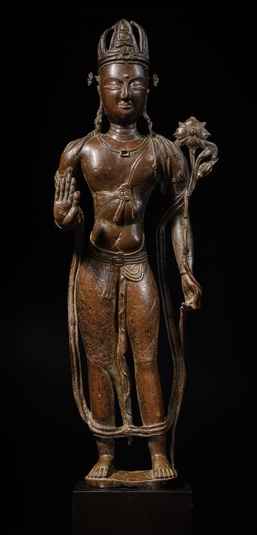
Item: Avalokiteshvara (Bodhisattva & Buddhist Deity) - (Standing Figure)
| Origin Location | Ladakh |
|---|---|
| Date Range | 1000 - 1099 |
| Lineages | Buddhist |
| Material | Metal, Copper Inlay, Silver Inlay |
| Collection | Private |
Alternate Names: Lokeshvara Avalokita Lokanata Lokanatha Mahakarunika
Classification: Deity
Appearance: Peaceful
Gender: Male
Padmapani Avalokiteshvara. (West Tibet or Ladakh).
Description & Definition: Padmapani (lotus holder) is a Sanskrit term referring to Lokeshvara, the bodhisattva, having one face and two hands. The left hand holds the stem of a blossoming lotus flower. The textual inspiration for the imagery of Lokeshvara in this appearance are the Sutras of the Mahayana tradition of Buddhism. Padmapani is also used as a synonym for Lokeshvara. The term is commonly found as an epithet, as well as a descriptive term, referring to the lotus held in the left hand. It has yet to be shown or proven textually that there is any specific and unique form of Lokeshvara accepted across the Indian Buddhist cultural sphere that is described in early literature as a Padmapani Avalokiteshvara.
Jeff Watt [added 9-2023]
Provenance: The Pan-Asian Collection of Christian Humann (1924-1981). Robert Hatfield Ellsworth (1929-2014), New York. Christie’s New York, 17 September 1999, lot 69. 泛亞收藏 安思遠(1929-2014),紐約 紐約佳士得1999年9月17日,編號69
Literature: Marylin M. Rhie and Robert A. F. Thurman, Wisdom and Compassion: The Sacred Art of Tibet, London, 1996, expanded edition, pp 136-37, cat. no. 28.
Robert E. Fisher, Art of Tibet, London, 1997, p. 44, fig. 26.
Collection of Ellsworth, Robert Hatfield
Buddhist Deity: Avalokiteshvara, Padmapani (With Krishnasara)
Collection: Sotheby's New York (Sculpture, September, 2023)
Buddhist Deity: Avalokiteshvara, Padmapani (Masterworks)
Buddhist Deity: Avalokiteshvara, Padmapani (Standing)
Buddhist Deity: Avalokiteshvara Main Page



